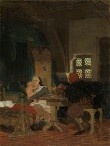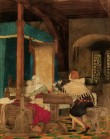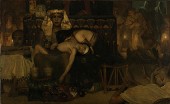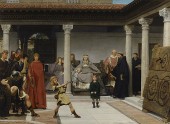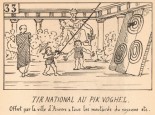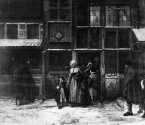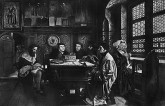The browser will either open the file, download it, or display a dialog.

An Unknown Flemish Interior in the Fourteenth Century by Lawrence Alma-Tadema
An unknown, untitled early oil painting by Sir Lawrence Alma-Tadema (1836–1912) has recently surfaced in a private collection in the Netherlands (fig. 1). The work is not included in Vern G. Swanson’s catalogue raisonné, which does feature, however, a similar work of larger dimensions entitled Flemish Interior in the Fourteenth Century (fig. 2).[1] This larger painting depicts a woman on a high-backed throne-like chair holding a baby in her arms, with a small blanket protecting her dress. She seems reluctant to give the baby to a man in a long gown, possibly a doctor, who stands in front of her and extends his arms to take the young child from her.[2] He has just stood up from a large table with a rich meal on it, where a second man, perhaps the woman’s husband, has stopped eating and attentively follows the scene in front of him. The room is further furnished with a decorated wooden cradle and an impressive bed, reminiscent of Flemish fifteenth-century paintings like Jan van Eyck’s Arnolfini Portrait of 1434.
The apparent tension, in the Swanson’s catalogue version, between the woman clinging to her baby and the man gesturing to take it from her, may suggest the depiction of a specific story or historical event. This tension is less strong, however, in the original version of the painting, which shows a second woman standing to the left of the chair, smiling and thus lightening the atmosphere.[3] Though the painting appears to have narrative qualities, it does not seem to have been Alma-Tadema’s intention to depict a specific story or event. The painting is entitled Interior: Fourteenth Century in the catalogue which Rudolf Dirckx published in 1910 on the basis of information provided by the artist himself.[4] It bears the same kind of generic title in the draft for a catalogue prepared by Alma-Tadema’s friend Carel Vosmaer in the 1880s and annotated by the artist himself.[5] Indeed, the painting belongs to a group of generically entitled genre scenes situated in the past, which Alma-Tadema painted in the 1860s, including works like Leaving Church in the Fifteenth Century (1864) and A Birth Chamber, Seventeenth Century (1868).
Unlike the larger version, and most of Alma-Tadema’s works from this period, the newly discovered, smaller painting does not have an opus number. As a result, it is not listed in Vosmaer’s and Dirckx’s catalogues. It is signed and dated, however, on the heavy crossbeam that supports the roof in the depicted interior. The medieval setting of the scene is similar to the one in the larger work, although it is more modest in both decoration and dimensions. The woman in the high-backed chair wears an unpretentious frock and what seems to be a gable hood over her wimple. She holds her baby close to her, as she does in the larger painting, apparently unwilling to hand it over to a plainly dressed man sitting at a small table next to her. His relaxed pose and the position of the table between him and the woman, however, defuse any menace that his gesture could suggest. The woman’s recoil, in fact, seems playful here rather than serious, and both she and the baby smile at the man. As a result, the scene suggests the enjoyment of domestic bliss by a young family rather than a possibly alarming event.
The small Flemish Interior in the Fourteenth-Century is dated 1863, like the larger one. It is too finished and too different, however, to be a sketch for the larger version. It may be a reduced variant of the larger painting or the latter may be an elaborated version of the smaller one. The absence of an opus number on the small version may suggest that it was a gift to, or a personal commission by, someone close to the artist, then still at the beginning of his career. The two heraldic images on the back of the throne-like chair, which do not appear in the larger version, may point in the same direction. They violate some of the most basic heraldic rules, but the arms on the right-hand side, displayed on an oval for the woman, apparently depict a Frisian eagle and three trefoils—or possibly acorns—a combination quite popular for family blazons in Friesland, where Alma-Tadema was born and grew up.[6] The arms on the left-hand side, a gold lion displayed on a red shield for the man, is harder to attribute with any certainty, but could refer to the province of Holland.
The conjecture that the painting was a gift or a personal commission may explain why it has survived. Few paintings of Alma-Tadema’s early Belgian period (1852–65), spent in Antwerp (before the artist moved to Brussels in 1865 and to London in 1870), have been preserved because the artist was often dissatisfied with the work he executed at the time and for this reason frequently destroyed it.[7] The painting also seems to have had a special meaning for the artist. A watercolor version of the work was kept by Alma-Tadema in his house until his death in 1912, when it passed to his daughter Anna, who lent it to her father’s posthumous retrospective exhibition at the Royal Academy in 1913 (fig. 3).[8] Considering the artist’s attachment to the composition, it is tempting to read it in self-referential terms. In 1863, when Alma-Tadema painted the work, he married his first wife Pauline Gressin Dumoulin (?–1869), who quickly became pregnant with their child and gave birth to a son in July 1864. Both mother and child, however, contracted smallpox, and a few months later the baby died. The couple would have two daughters afterwards, but they would never have another son. It has been suggested that Alma-Tadema’s Death of the Firstborn (fig. 4), which represents the Pharaoh of Egypt and his wife mourning over their dead son, could refer to this personal loss.[9] The painting dates from 1872 and takes up a theme that Alma-Tadema had already treated in The Sad Father, dated 1859, but it is striking that in 1879 he bought the work back from his dealer Ernest Gambart (1814–1902) and subsequently kept it in a special, almost shrine-like place in his studio until his death.[10] The watercolor version of the Flemish Interior in the Fourteenth Century, which Alma-Tadema also kept in his studio, functioned perhaps as an emotional pendant for this work. Painted while he and his (future) wife were preparing for their marriage or already expecting the birth of their son, it seems not improbable that the Dutch artist projected in this work his dreams of a blissful family life, blessed with a golden-tressed offspring.
Although reading an artist’s personal biography in his artistic output in this way is delicate, Alma-Tadema’s work lends itself quite well to it. The artist’s historical scenes, be they set in ancient Egypt, in the Middle Ages or in Classical Rome, can nearly always be read as historical transpositions of modern life.[11] This is certainly true of his generic historical genre scenes, which the public was used to seeing as modern scenes in historical dress. Scenes depicting actual historical events, however, could be read in very much the same way. At the tri-annual Antwerp Salon of 1861, for instance, Alma-Tadema exhibited The Education of the Grandchildren of Clotilde (fig. 5; usually known under the mistaken title The Education of the Children of Clovis), an ambitious historical painting representing an obscure chapter in the life of the Merovingian Queen Clotilde.[12] In a little known booklet of caricatures published on the occasion of the Salon, the scene was mockingly repeated as a quasi-contemporary scene (fig. 6). In the caricature, the young Merovingian princes practicing the martial arts have become participants in the “tir national,” Belgium’s annual national shooting competition, now depicted, however, as a children’s game of “vogelpik” or darts (the word “vogelpik” or “pik voghel” referring to the beak of a bird, hence the bird hanging from a rope in the caricature).
The suggestion of possible continuities between the past and present was an important element in the appeal of many historical genre pictures of the time. Alma-Tadema may have learned this lesson from the Belgian painter Henri Leys (1815–69). According to Alma-Tadema’s own account, he left the studio of Louis De Taeye (1822–90), his former teacher at the Antwerp Royal Academy of Fine Arts, in 1860, in order to continue his studies under Leys’s guidance. Although claims about Alma-Tadema’s contribution to the murals Leys executed in the 1860s in the Antwerp city hall are not convincing, he was, nevertheless, probably a member of the older painter’s close circle.[13] He stressed the association with Leys in various interviews which he gave at a later age and had the phrase “student of Henri Leys” included after his name in catalogues and Salon livrets from 1864 onward in Paris and in London where Leys’s name could generate attention for his own.[14] Alma-Tadema was probably also allowed to study Leys’s substantial art collection. The library of the University of Birmingham holds a page by Alma-Tadema with studies in watercolor of figures from Pieter Breughel the Younger’s The Kermesse of St George, a version of which hung in Leys’s studio.[15]
The impact of Leys on Alma-Tadema’s art can only be touched upon here, but it is telling that Leys’s New Year in Flanders (fig. 7), a transitional work dated 1853, was lampooned in almost the same way as The Education of the Grandchildren of Clotilde, which was in fact the first work the younger artist painted under Leys’s guidance.[16] Leys’s work depicts a mother and her children leaving an old Antwerp house, possibly the children’s grandparents’ house, where they have collected their New Year gifts: an herb bread and a pastry rooster on a stick. The Belgian art critic Louis Hymans described the visit as an ancient Flemish custom that lived on in the present.[17] A caricature of the painting, published in 1854, which depicts the child with the rooster, made the same point (fig. 8). The caricature’s text read: “The author [of the painting] shows us that the origins of Ontje Pyke are lost in the night of time” (“Ontje Pyke” or “Haantje Pik,” literally translated as “rooster peck,” refers to the traditional parade of children carrying around town a rooster on a decorated stick on Palm Sunday). [18]
Whether the habits of giving and receiving New Year’s gifts or parading with a rooster on a stick actually did exist in sixteenth-century Antwerp, as Leys’s painting suggests, is not really relevant: it did exist in his own time, and the public could thus recognize a scene from their own everyday lives in a representation of the past, as they could project the national shooting competition on The Education of the Grandchildren of Clotilde. Looking in this way at the past seems fanciful or, at least, hard to reconcile with the archaeological ambitions often attributed to Leys’s and Alma-Tadema’s historical reconstructions. Both artists, however, deliberately sought this confusion between past and present, and it accounted for much of their success.[19] One way to look at this is by not discarding the suggestion of a parallel between past and present as a historical falsification, but seeing it as an attempt to make the past live again, as a visible and tangible reality.[20] An anecdote which Alma-Tadema associated with The Education of the Grandchildren of Clotilde is perhaps telling in this respect. Looking back on his time with Leys, the Dutch painter remarked that his master was “an uncommonly severe critic.” Not only did Leys reject the marble in The Education of the Grandchildren of Clotilde as looking too cheese–like, he was also critical of the Gothic table which he had asked the younger artist to draw in his own painting, The Interior of Luther’s House in Wittenberg (fig. 9).[21] Seeing the table which Alma-Tadema had added to his composition, Leys purportedly observed: “Yes, but I wanted to see the kind of Gothic table that people knock their knees against.”[22] The anecdote itself is probably apocryphal. Leys painted The Interior of Luther’s House in Wittenberg on the basis of a detailed oil sketch of Luther’s study (which still exists) in the Lutherhaus in Wittenberg, including the reformer’s original worktable, to which the artist simply added the figures of Luther and his associates. In addition, it was not Alma-Tadema but Leys’s nephew and pupil Henri De Braekeleer (1840–88) who was sent to Wittenberg to make the study, and it seems probable that it was he who also assisted the older painter further with the painting.[23] This, however, does not make the anecdote meaningless. Leys’s remark, as recorded by Alma-Tadema, should perhaps not be understood as bearing, or bearing only, on the archaeological accuracy of the table in the Lutherhaus. “A Gothic table that people knock their knees against” also evokes the idea of knocking one’s own knees against the table—of actually feeling the past as if one was there, and thus bridging the gap between then and now, past and present.
Seen in this light, this is exactly what Alma-Tadema’s Flemish Interior in the Fourteenth Century allowed the viewer to do: to knock his or her knees against a fourteenth-century table (the table in the painting, in fact, rather resembles the one in The Interior of Luther’s House in Wittenberg), and to bridge the gap between the past and present. It matters, in the end, little if the artist had his own dreams of a happy family life in mind when he painted the picture, or even whether he projected his own situation on the painting at a later stage. What does matter is that the Flemish Interior in the Fourteenth Century, like so many of Alma-Tadema’s pictures, suggested that the past was not so different from the present and that this allowed the viewer to project his own world, life, dreams or disappointments onto it.
Jan Dirk Baetens
Radboud University Nijmegen
j.baetens[at]let.ru.nl
Many thanks for all their help in various ways to Marina Aarts, Luc Duerloo, Ben Read, Jan Van der Stock, Petra ten-Doesschate Chu, and G. D. C. Vosmaer.
[1] Vern G. Swanson, The Biography and Catalogue Raisonné of the Paintings of Sir Lawrence Alma-Tadema (London: Garton, 1990), 131. Swanson gives the following alternative titles for this larger work: A Flemish Interior in the Thirteenth Century and A Flemish Interior.
[2] See on the man’s gown: L. Cabanès, Le Costume du médecin en France des origines au XVIIIe siècle (Paris: P. Longuet, 1921), 22.
[3] The illustration in Swanson’s catalogue raisonné, apparently a reproduction of an old photograph taken before Alma-Tadema retouched the painting, shows the original version. The illustration in this article shows the painting after the artist removed the second woman.
[4] Rudolf Dirckx, “The Later Work of Sir Lawrence Alma-Tadema,” The Art Journal 62 (1910), Special Christmas supplement, 25. The author mentions Alma-Tadema’s help in a footnote.
[5] Swanson was able to consult this manuscript, then in the possession of the Vosmaer family, but its current location is unknown. It is no longer in the hands of the Vosmaer family, but it was not included in the family archives that were transferred to the Dutch National Archives in the 1980s either. Vosmaer family archives, Collection 548, National Archives, The Hague.
[6] The arms of the Vlara family in Frisia seem to come closest to the arms depicted. The arms are, nevertheless, heraldically incorrect. The lion on the shield faces the wrong direction and the eagle on the second sign should have been put on the left-hand side, facing the left.
[7] Lawrence Alma-Tadema, “Laurens Alma-Tadema, R.A.,” in In the Days of My Youth, ed. T. P. O’Connor (London: C. Arthur Pearson, 1901), 203. See on Alma-Tadema’s Belgian period: Saskia de Bodt, “‘Hoe men schilder wordt.’ De Belgische tijd van Lourens Alma Tadema,” in Erkend en miskend: Lourens Alma Tadema (1836–1912) in België en Nederland, ed. Saskia de Bodt and Maartje de Haan, exh. cat. (Amsterdam and Ghent: Ludion, 2003), 9–28; Teio Meedendorp and Luuk Pijl, “Alma-Tadema en de Lage Landen,” in Sir Lawrence Alma-Tadema, ed. Edwin Becker, Edward Morris, Elizabeth Prettejohn and Julian Treuherz, exh. cat. (Zwolle: Waanders, 1996), 21–30; and Swanson, Biography and Catalogue Raisonné, 23–37.
[8] London, Royal Academy, Exhibition of Works by the Late Sir Lawrence Alma-Tadema R.A. O.M., exh. cat. (London: William Clowes, 1913), 36. The work was exhibited as Interior: 14th Century. The catalogue describes the work in detail and mentions it as a small version of an oil painting done in 1863.
[9] Becker and others, Sir Lawrence Alma-Tadema, 172.
[10] Ibid.
[11] See for instance Elizabeth Prettejohn, “Lawrence Alma-Tadema and the Modern City of Ancient Rome,” Art Bulletin 84, no. 1 (March 2002): 115–29.
[12]Exposition nationale. Catalogue des ouvrages de peinture, sculpture, architecture, gravure et dessin, exécutés par des artistes vivants, et exposés au salon d’Anvers, exh. cat. (Antwerp: Société Royale pour l’Encouragement des Beaux-Arts, 1861), 42. The catalogue gives the correct title and explains the subject. See also Maartje de Haan, “‘Zoo hij van sommige kanten onderschat werd, kan men bij de tegenovergestelde zijde toch kwalijk op overschatting wijzen.’ De waardering in Nederland voor de schilder Lourens Alma Tadema, een beroemde landgenoot in den vreemde,” in de Bodt and de Haan, Erkend en miskend, 32–33.
[13] Helen Zimmern, Sir Lawrence Alma Tadema R.A. (London: George Bell and Sons, 1902), 6. In the same sense, but less explicitly: Edmund W. Gosse, “Lawrence Alma-Tadema, R.A.,” in Illustrated Biographies of Modern Artists, ed. F. G. Dumas (London and Paris: Chapman and Hall - Ludovic Baschet, 1882), 79. Although Alma-Tadema may have been involved in some of the preparatory studies, archival documents indicate that Leys was assisted in the city hall only by Louis Hendrickx, Franz Vinck, and Albrecht De Vriendt (as well as the decorative painter Jan Baetens for the blazons, inscriptions, etc). See Record of the Meeting of the Commission Provinciale des Monuments of May 13, 1903, MA 6419, Felix Archives (Antwerp City Archives), Antwerp.
[14] Alma-Tadema, “Laurens Alma-Tadema, R.A.,” 203. Salon de 1864. Explication des ouvrages de peinture, sculpture, architecture, gravure et lithographie des artistes vivants, exh. cat. (Paris, 1864), 6; and London, Twelfth Annual Exhibition in London of Pictures, the Contributions of Artists of the French and Flemish Schools, exh. cat. (London, 1865), 3.
[15]Catalogue de la fresque et des tableaux, esquisses, aquarelles, dessins composant l'atelier Leys, auction cat. (Antwerp, December 19–23, 1893), 33; and Portfolio nr. 57, E1939-E1959, Special Collections, Alma-Tadema Archives, University of Birmingham, Birmingham.
[16] Alma-Tadema, “Laurens Alma-Tadema, R.A.,” 204.
[17] Louis Hymans, “Exposition des beaux-arts à Bruxelles,” L’Illustration 12, July-December 1854, 200.
[18]Les Turcs au salon repoussant l’invasion des Cosaques (Brussels, n.d. [1854]), n.p. Translation by the author.
[19] Louise Lippincott, Lawrence Alma Tadema: Spring (Malibu: The J. Paul Getty Museum, 1990), 71; and Prettejohn, “Lawrence Alma-Tadema and the Modern City,” 120–28.
[20] Stephen Bann, The Clothing of Clio: A Study of the Representation of History in Nineteenth-Century Britain and France (London and New York: Cambridge University Press, 1984).
[21] Alma-Tadema, “Laurens Alma-Tadema, R.A.,” 204.
[22] Ibid.
[23] Herwig Todts, Henri De Braekeleer 1840–1888, exh. cat. (Antwerp: Royal Museum of Fine Arts, 1988), 23–24; and Mark-Edo Tralbaut, De Braekeleeriana: Archivalia, rariora en curiosa in verband met leven en werk van de Antwerpse kunstschilder (Antwerp: Stad Antwerpen, 1972), 278–79.


